Roofing Companies Warren
Find top Roofing Service in Warren
Receive 3 FREE Roofers quotes for your project today! Compare profiles, reviews, accreditations, portfolio, etc... and choose the best deal.
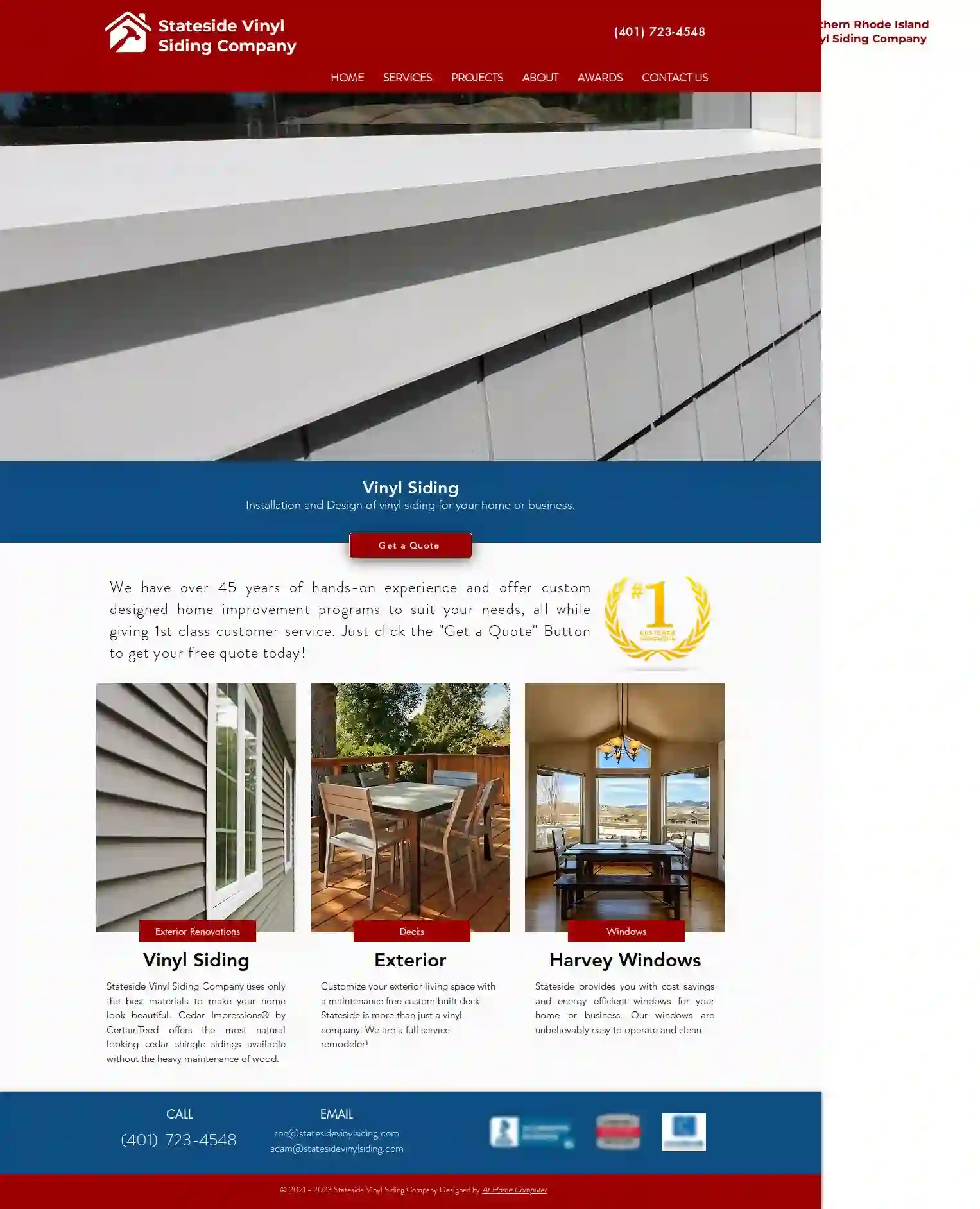
STATESIDE VINYL SIDING CO. INC.
4.318 reviewsWarwick, USStateside Vinyl Siding Company is a family-owned and operated business serving Northern Rhode Island for over 45 years. We specialize in providing high-quality vinyl siding, windows, roofing, decks, and sunrooms. Our team of experienced professionals is dedicated to delivering exceptional customer service and custom-designed home improvement solutions to meet your unique needs. We use only the best materials, such as Cedar Impressions® by CertainTeed, to ensure your home looks beautiful and lasts for years to come. We also offer energy-efficient windows from Harvey Windows to help you save money on your energy bills. Contact us today for a free quote and let us transform your home's exterior!
- Services
- Why Us?
- Gallery
Get Quote
Couto Construction
5136 reviews24 Ernest St, New Bedford, 02745, USGet up to Labor on Full Roof Replacements Independence From Leaks *Minimum of 1,500 sq. ft. Contact us for details. Other exclusions may apply. Offer Valid until July 31st. What’s on your to-do list? Roofing Siding Windows Doors GET STARTED! Home improvement without the stress. Our Family’s Got Yours Covered. Serving Southeast Massachusetts and Rhode Island New Bedford’s most trusted home exterior contractors You’ve probably seen one of our trucks in the New Bedford area, and for good reason— we’re busy! With hundreds of 5-star reviews on Google, Couto Construction has quickly become the most trusted home exterior contractor in New Bedford. We specialize in residential roofing, siding, and windows services using the industry’s highest rated materials. Contact Us View All Awards Our Exterior Home Remodeling Services Roofing Siding Windows Get a Quote Why Homeowners Choose Couto Construction We’re changing the industry. Our vision is a world where home improvements are exciting and worry-free. Our contractors are certified and verified by some of the top vendors in the business, and we’re insured to protect you and your home. We’ll be here when you need us, as we have been for more than 30 years. In Business Since 1987 Warranties up to 50 years Local, Family-Owned Company Certified & Verified Contractors Free Estimates The price matters. Instant, FREE roofing, siding, and window estimates Get instant estimates for roofing, siding, or windows based on your project specifications with our home exterior cost calculators! Roof CalculatorSiding CalculatorWindow Calculator Don’t just take our word for it! 4.8out of 3100+ real reviews! View all J.D. Couto Construction installed, Siding, Shutters, Windows, Doors, Gutters on our home. The house is quite large with lots of additions which have been added over the years since 1910. These additions create LOTS of bends , turns, nooks and crannies. Honestly this was not cheap, as it was a huge project. Claudio, David, Carlos, Rickey, Marianna, and Lori, hopefully I did not leave anyone out, Worked with us EVERY step of the way!! From the first day that we met Claudio and David, we knew that the Couto family and our family would be joined together. The project was thoroughly discussed, we and they made suggestions and changes during the project. The contract was absolutely written to include EVERYTHING! I liked that because I referred to the contract many times during the project. I was amazed that at no point was stressed out, which is VERY unusual for me. I relaxed and trusted for once in my life. All is perfect! Thank you Couto family!! The Gray pictures are Before and the Red pictures are after. J From the very first encounter with Sales Rep Corey, to the job manager Cesar and his crew, we were extremely happy with Couto Construction. We hired them for siding installation. They came highly recommended from a friend, and had great reviews. From the moment we booked them, we had no anxiety about not getting the results we expected. We really appreciated the App they use doing the process to keep you up-to-date on progress and any issues they find. Cesar was very attentive to any questions we had or issues uncovered during the job. We can't say enough positive things about the work ethic, and quality of work Cesar's crew did. Their attention
- Services
- Why Us?
- Our Team
- Testimonials
- Gallery
Get Quote
Robinson Roofing, Inc
4.945 reviews15 Eben Brown Lane, Central Falls, 02863, USRobinson Roofing is a local business that provides roofing services to residential and commercial clients. We are proud to have Rhode Island as our home and take pride in protecting its buildings. Our team of certified professionals has experience in both residential and commercial roofing, handling jobs from simple gutter repairs to full roof installations. We use high-quality materials and focus on providing quality service at affordable rates. Our experts are available for inquiries and can be reached through our 'contact us' button or by visiting our office for quotes.
- Services
- Why Us?
- Our Team
- Testimonials
- Gallery
Get Quote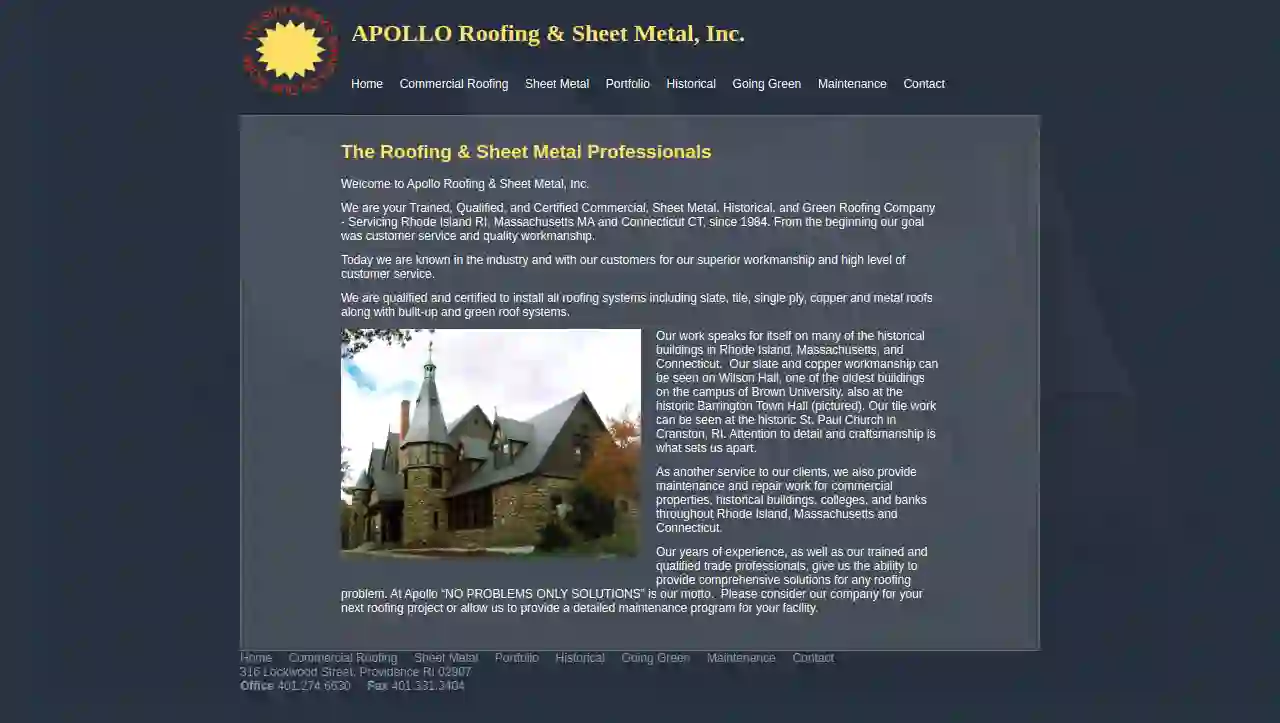
Apollo Roofing & Sheet Metal, Inc.
3.73 reviews316 Lockwood Street, Providence, 02907, USWelcome to Apollo Roofing & Sheet Metal, Inc. We are your Trained, Qualified, and Certified Commercial, Sheet Metal, Historical, and Green Roofing Company - Servicing Rhode Island RI, Massachusetts MA and Connecticut CT, since 1984. From the beginning our goal was customer service and quality workmanship. Today we are known in the industry and with our customers for our superior workmanship and high level of customer service. We are qualified and certified to install all roofing systems including slate, tile, single ply, copper and metal roofs along with built-up and green roof systems. Our work speaks for itself on many of the historical buildings in Rhode Island, Massachusetts, and Connecticut. Our slate and copper workmanship can be seen on Wilson Hall, one of the oldest buildings on the campus of Brown University, also at the historic Barrington Town Hall (pictured). Our tile work can be seen at the historic St. Paul Church in Cranston, RI. Attention to detail and craftsmanship is what sets us apart. As another service to our clients, we also provide maintenance and repair work for commercial properties, historical buildings, colleges, and banks throughout Rhode Island, Massachusetts and Connecticut. Our years of experience, as well as our trained and qualified trade professionals, give us the ability to provide comprehensive solutions for any roofing problem. At Apollo “NO PROBLEMS ONLY SOLUTIONS” is our motto. Please consider our company for your next roofing project or allow us to provide a detailed maintenance program for your facility.
- Services
- Why Us?
- Gallery
Get Quote
Midland Roofing Company, Inc.
4.9131 reviewsWarwick, USYour Local Roof Replacement Experts, Midland Roofing, has been serving Rhode Island for over 40 years. We are a GAF Master Elite® roofing contractor and a proud recipient of multiple GAF President’s Club awards, demonstrating our commitment to delivering top-tier workmanship and customer service. We specialize in roof and skylight replacement, using high-quality asphalt shingles available in a variety of styles and colors to beautify your home. At Midland Roofing, we believe in setting strong standards for customer service and workmanship. We offer free estimates, affordable financing, and no deposit required to get started. Our team is dedicated to providing a hassle-free experience, with no high-pressure sales tactics. We want you to feel confident and informed throughout the entire process. Contact us today to learn more about our services and request a free estimate for your next roofing project.
- Services
- Why Us?
- Accreditations
- Gallery
Get Quote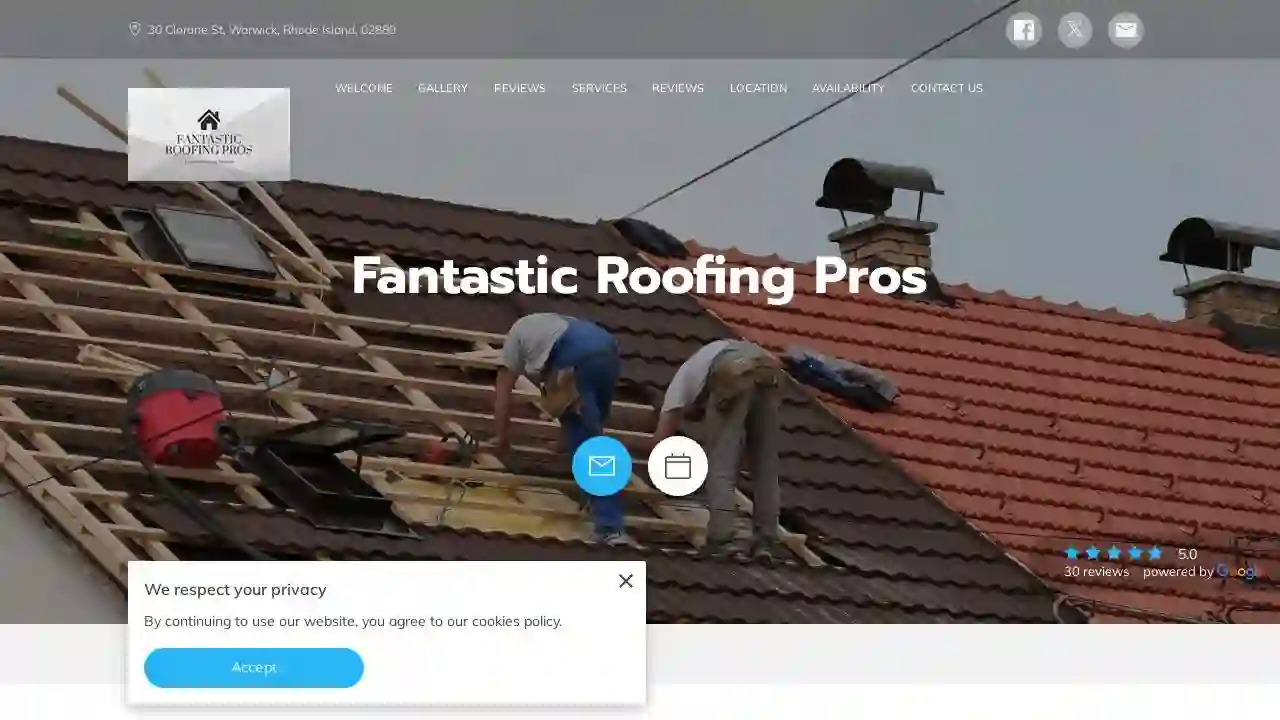
Fantastic Roofing Pros
521 reviews30 Clorane St, Warwick, 02889, USAt Fantastic Roofing Pros, you'll find a family run and owned business in Warwick with years of experience. We are the roofers - all the work is carried out by us, not sub-contractors, so you know the quality is going to be high. With very low overheads we know we can deliver a high-quality service at a competitive price. We offer a complete range of roofing services, from minor repairs to a completely new roof. Our skilled team can advise on the different options to fit your taste and budget, and they have the experience to provide solutions for residential and commercial properties.
- Services
- Why Us?
- Testimonials
- Gallery
Get Quote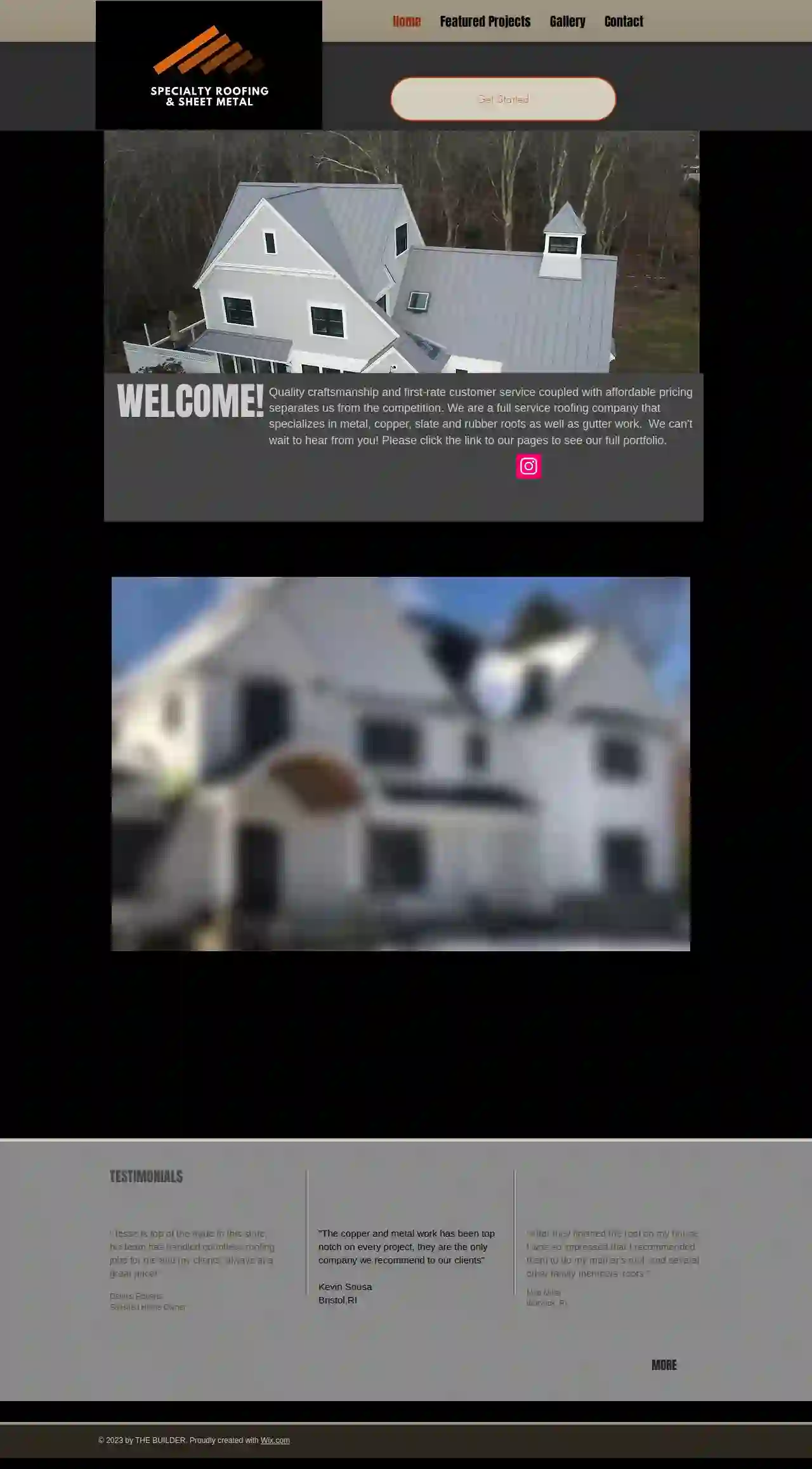
Specialty Roofing and Sheet Metal, LLC
51 reviewsWarwick, USQuality craftsmanship and first-rate customer service coupled with affordable pricing separates us from the competition. We are a full service roofing company that specializes in metal, copper, slate and rubber roofs as well as gutter work. We can't wait to hear from you! Please click the link to our pages to see our full portfolio.
- Services
- Why Us?
- Testimonials
- Gallery
Get Quote
Above All Roofing
4.322 reviewsWarwick, USAbove All Roofing Inc. is a family owned and operated roofing company serving the greater Houston area. We are fully licensed and insured, and we have over 20 years of experience in the roofing industry. We offer a wide range of roofing services, including roof repair, roof replacement, and new roof construction. We are committed to providing our customers with the highest quality workmanship and customer service.
- Services
- Why Us?
Get Quote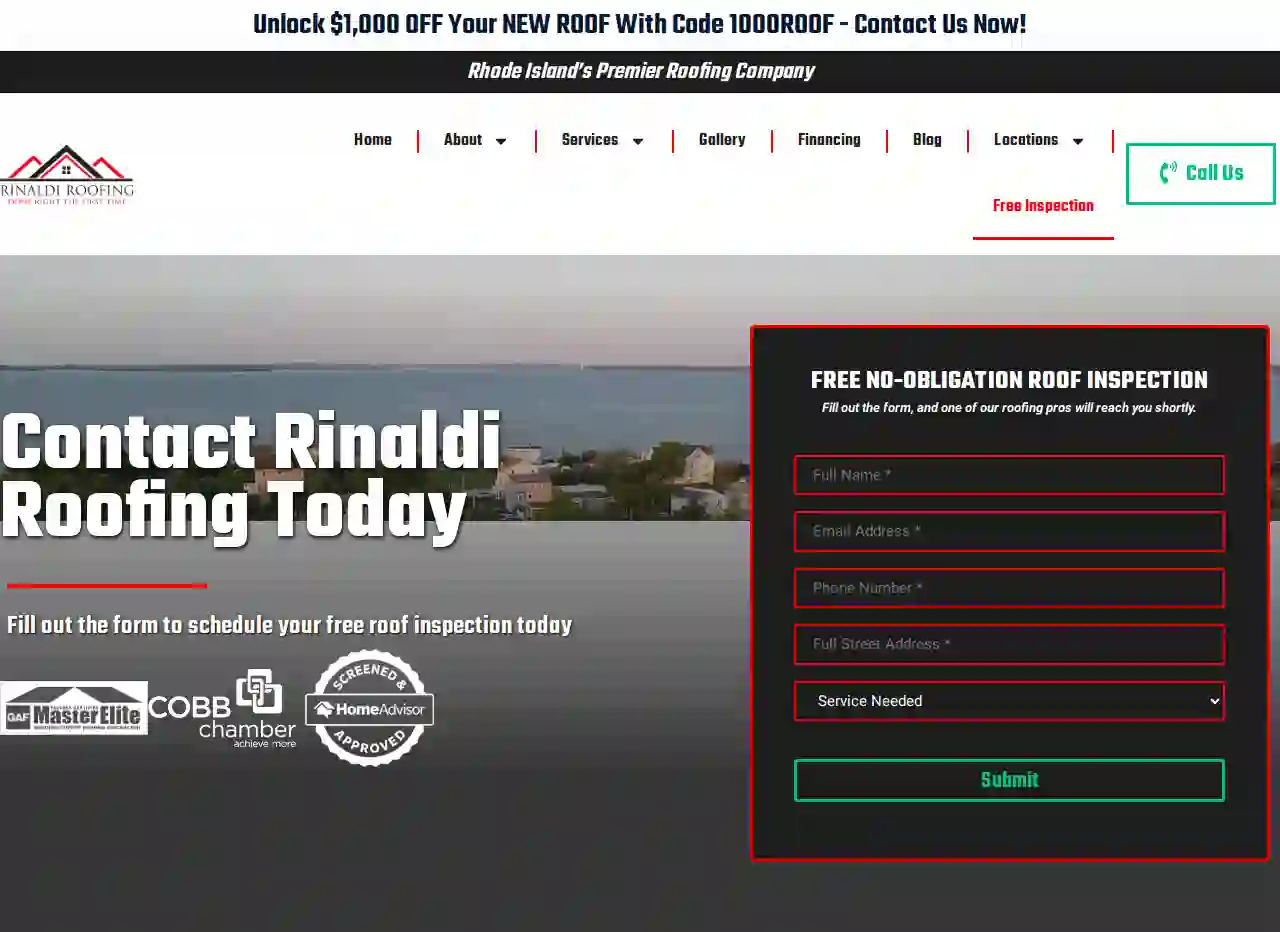
Rinaldi Roofing
568B Mooresfield Rd, South Kingstown, 02879, USRinaldi Roofing is Rhode Island’s most trusted restoration team, boasting over 10 years of experience in providing unmatched customer service and professional roofing services. We are dedicated to delivering high-quality roofs that last, using only the best roofing materials available. Our commitment to our Rhode Island neighbors extends beyond just quality materials; we strive to build meaningful relationships with homeowners and businesses by being a part of the community we serve. At Rinaldi Roofing, we understand that your roof is your first line of defense against the elements, and we don't want you to have to sacrifice quality for affordability. We offer a variety of services, including residential and commercial roofing, siding, gutters, decks, and emergency roof tarping, all at fair prices with zero hidden fees. We treat our clients like family, always striving to deliver A+ customer service that you can rely on.
- Services
- Why Us?
- Gallery
Get Quote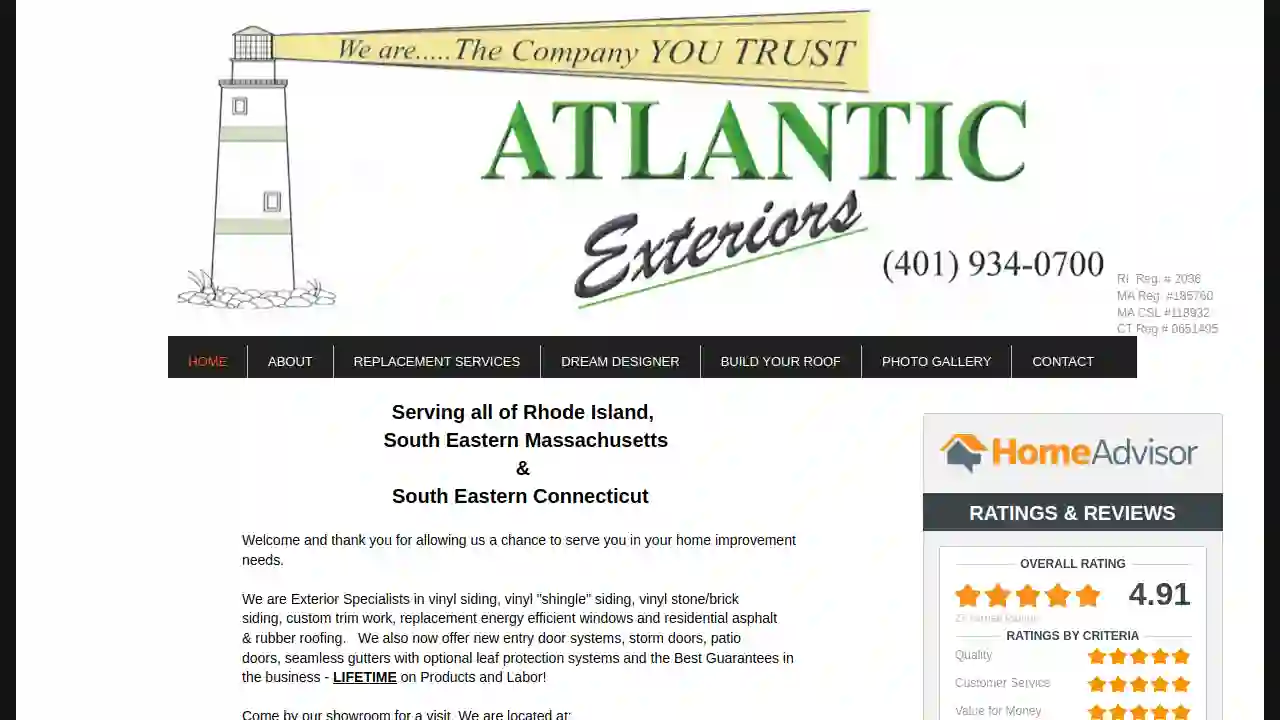
Atlantic Exteriors
4.727 reviews274 Woonasquatucket Ave, North Providence, 02911, USWelcome and thank you for allowing us a chance to serve you in your home improvement needs. We are Exterior Specialists in vinyl siding, vinyl "shingle" siding, vinyl stone/brick siding, custom trim work, replacement energy efficient windows and residential asphalt & rubber roofing. We also now offer new entry door systems, storm doors, patio doors, seamless gutters with optional leaf protection systems and the Best Guarantees in the business - LIFETIME on Products and Labor! Come by our showroom for a visit. We are located at: 274 Woonasquatucket Ave, North Providence, RI 02911 Please contact us today for a Free Estimate.
- Services
- Why Us?
- Gallery
Get Quote
Over 17,196+ Roofers in our network
Our roofing pros operate in Warren & beyond!
Roofyng.com has curated and vetted Top Roofers arround Warren. Find a trustworthy contractor today.
Frequently Asked Questions About Roofing Companies
- Age: If your roof is nearing or exceeding its expected lifespan, it's wise to consider replacement.
- Multiple Leaks: Several leaks or leaks that reappear after repairs suggest a widespread problem.
- Extensive Damage: Large areas of damaged, missing, or deteriorated roofing materials might be too costly or difficult to repair effectively.
- Sagging or Structural Issues: Sagging, deflection, or other structural issues indicate a compromised roof that needs replacement.
- Granule Loss (Asphalt Shingles): Significant granule loss indicates weathering and reduced protection.
- Curling or Buckling Shingles: Signifies age or improper ventilation.
- Increased Energy Bills: A poorly insulated roof can lead to higher heating and cooling costs.
- Choose Reflective Roofing Materials: Opt for light-colored shingles or metal roofing that reflects sunlight and reduces heat absorption.
- Install Proper Attic Insulation: Adequate insulation prevents heat loss in the winter and heat gain in the summer.
- Ensure Adequate Ventilation: Proper attic ventilation allows hot air to escape, reducing cooling costs and extending the lifespan of your roof.
- Consider a Radiant Barrier: In hot climates, a radiant barrier installed in the attic can reflect heat away from the roof, further reducing cooling needs.
- Metal roofs: Reflect sunlight, reducing cooling costs.
- Tile roofs: Offer thermal mass, regulating temperature.
- Cool roofs: White or light-colored roofs with high solar reflectance.
- Green roofs: Vegetated roofs providing insulation and reducing heat absorption.
- Asphalt Shingles: Popular, affordable, available in various styles (3-tab, architectural, etc.)
- Metal Roofing: Durable, long-lasting, energy-efficient, available in panels, shingles, or tiles.
- Tile Roofing: Clay, concrete, or slate; known for longevity, durability, and aesthetic appeal.
- Flat Roofing: EPDM rubber, TPO, PVC, modified bitumen, or built-up roofing (BUR).
- Slate: Natural stone, extremely durable, expensive, requires expert installation.
- Wood Shakes or Shingles: Natural wood, aesthetically pleasing, requires regular maintenance.
What are the signs that my roof needs to be replaced?
How can I make my new roof more energy-efficient?
What are some energy-efficient roofing options?
What are the different types of roofing materials?
What are the signs that my roof needs to be replaced?
- Age: If your roof is nearing or exceeding its expected lifespan, it's wise to consider replacement.
- Multiple Leaks: Several leaks or leaks that reappear after repairs suggest a widespread problem.
- Extensive Damage: Large areas of damaged, missing, or deteriorated roofing materials might be too costly or difficult to repair effectively.
- Sagging or Structural Issues: Sagging, deflection, or other structural issues indicate a compromised roof that needs replacement.
- Granule Loss (Asphalt Shingles): Significant granule loss indicates weathering and reduced protection.
- Curling or Buckling Shingles: Signifies age or improper ventilation.
- Increased Energy Bills: A poorly insulated roof can lead to higher heating and cooling costs.
How can I make my new roof more energy-efficient?
- Choose Reflective Roofing Materials: Opt for light-colored shingles or metal roofing that reflects sunlight and reduces heat absorption.
- Install Proper Attic Insulation: Adequate insulation prevents heat loss in the winter and heat gain in the summer.
- Ensure Adequate Ventilation: Proper attic ventilation allows hot air to escape, reducing cooling costs and extending the lifespan of your roof.
- Consider a Radiant Barrier: In hot climates, a radiant barrier installed in the attic can reflect heat away from the roof, further reducing cooling needs.
What are some energy-efficient roofing options?
- Metal roofs: Reflect sunlight, reducing cooling costs.
- Tile roofs: Offer thermal mass, regulating temperature.
- Cool roofs: White or light-colored roofs with high solar reflectance.
- Green roofs: Vegetated roofs providing insulation and reducing heat absorption.
What are the different types of roofing materials?
- Asphalt Shingles: Popular, affordable, available in various styles (3-tab, architectural, etc.)
- Metal Roofing: Durable, long-lasting, energy-efficient, available in panels, shingles, or tiles.
- Tile Roofing: Clay, concrete, or slate; known for longevity, durability, and aesthetic appeal.
- Flat Roofing: EPDM rubber, TPO, PVC, modified bitumen, or built-up roofing (BUR).
- Slate: Natural stone, extremely durable, expensive, requires expert installation.
- Wood Shakes or Shingles: Natural wood, aesthetically pleasing, requires regular maintenance.